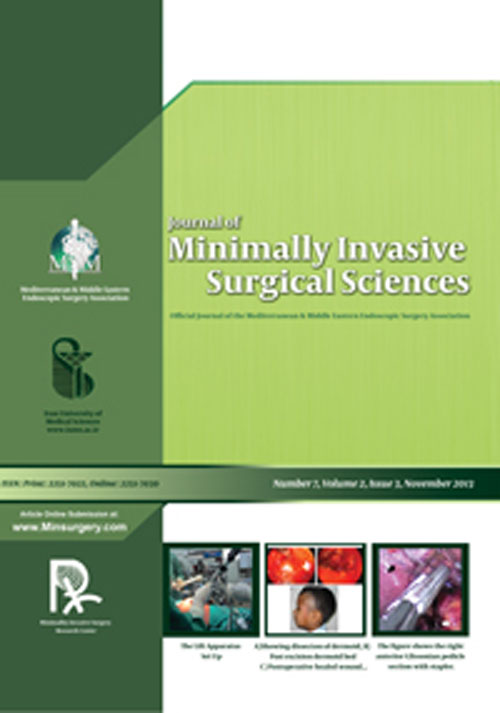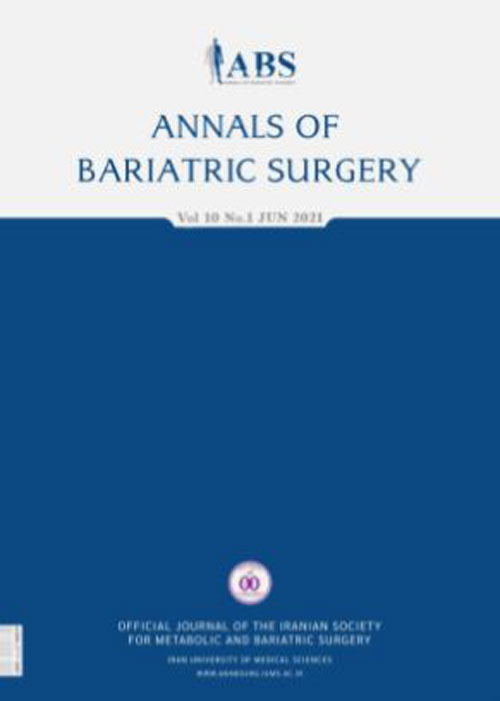فهرست مطالب

Annals of Bariatric Surgery
Volume:3 Issue: 3, Summer 2014
- تاریخ انتشار: 1393/06/03
- تعداد عناوین: 8
-
-
Page 1IntroductionWith the growing popularity of totally extraperitoneal (TEP) laparoscopic inguinal hernia repair, many surgeons will inevitably face the clinical conundrum of how to simultaneously repair an umbilical hernia and an inguinal hernia via TEP approach..Case PresentationIn this case report, we describe the successful use of the umbilical hernia defect to insert the balloon dissector and gas insufflator in the pre-peritoneal plane without making an additional fascial incision..ConclusionsWe suggest that this best preserves the integrity of the umbilical hernia repair by avoiding an additional area of weakness in the rectus sheath..Keywords: Hernia, Hernia, Inguinal, Hernia, Umbilical, Laparoscopy, General Surgery
-
Page 2IntroductionAGB (adjastable gastric bandin) is the most common method for treatment of obesity which is performed all around the world and provides a significant weight loss for patients. Despite all its benefits as a method that requires the least intervention, complications such as gastric prolapse, stoma stenosis and migration band may also occur. These complications rarely result in mortality, but usually the only treatment for them is surgery..Case PresentationWe report a rare complication of this procedure which had caused small intestine obstruction..ConclusionsSmall intestine obstruction caused by band migration is a very rare complication and must be considered as a differential diagnosis in patients with small intestine obstruction symptoms. Therefore correct surgical methods must be adopted for its treatment so that it may not let the surgeon get misled during the operation and let him do the treatment correctly..Keywords: Small Inestine, Morbid Obesity, Laparoscopy
-
Page 3BackgroundAlthough many studies have demonstrated the feasibility of single-incision laparoscopic (SILS) appendectomy, this procedure has not become routine. In part this may be due to the perception that SILS appendectomy has additional resource requirements compared to conventional laparoscopic appendectomy in terms of personnel, time and equipment..ObjectivesThe purpose of this prospective study was to assess the feasibility of a UK trainee performing routine SILS appendectomy with standard equipment..Patients andMethodsProspective analysis of all consecutive adults who underwent laparoscopy for presumed appendicitis was performed. Cases were performed either by a senior trainee who exclusively performed SILS appendectomy on all patients using standard laparoscopic equipment, or other senior or junior trainees performing a conventional three-port laparoscopic appendectomy..ResultsSeventeen patients had SILS operations: 15 appendectomies, one resection of inflamed Meckel’s diverticulum and one appendectomy with oophorectomy. SILS was successfully completed in 14 cases whilst in three cases one extra port was added. Comparison of the 15 SILS operations that involved an appendectomy only with consecutive cohorts of three-port appendectomies performed by junior and senior trainees showed no significant difference in complications or length of hospital stay. There was no significant difference in operating time between SILS and junior trainee (P = 0.54), however the senior trainees had a significantly reduced operating time as compared to both SILS and junior trainee groups (P = 0.01)..ConclusionsSILS appendectomy can be successfully performed by trainees on all-comers with comparable resource utilisation and clinical outcomes to those achieved by junior trainees performing a conventional three-port laparoscopic approach..Keywords: Appendectomy, Laparoscopy, Minimally Invasive Surgery, Surgery
-
Page 4BackgroundThe use of laparoscopic appendectomy for pediatric patients has been widely accepted and three trocars are usually necessary to perform a conventional laparoscopic appendectomy. However, single-port appendectomy represents an attractive alternative for children. Recently the use of a single umbilical incision to perform an appendectomy has been described..ObjectivesThe purpose of this study was to review our initial experience with transumbilical laparoscopic-assisted appendectomy (TULAA) in the pediatric population.. Patients andMethodsA retrospective review of all pediatric patients aged 3-16 (median: 10. 2 years) treated for appendicitis was performed from Jan 2010 to July 2013. Five mm infraumbilical port was used as camera port at 6 O’ clock position. The incision was extended along the border of umbilicus to 9 O’ clock position and another 5 mm working instrument was passed through different subfascial opening in the same incision. Patients variables (age and sex), intra-operative findings, duration of surgery, duration of stay, time of discharge, course in the ward, postoperative events like pain, nausea, vomiting and wound status were assessed. Postoperatively patients were followed up after 10 days, 3 months and 6 months. Cosmetic evaluation was done at 3rd and 6th months..ResultsOf 58 patients undergoing TULLA, 55 patients underwent TULAA successfully. The mean operative time was 52 minutes. Overall, the average length of stay was 1. 2 ± 0. 8 days. Postoperative course was uneventful in all the patients. There were no significant episodes of nausea, vomiting and pain. Postoperatively at 3rd and 6th months of follow-up the appearance of scar was cosmetically acceptable to every patient as well as their parents. It is much cheaper because the procedure can be performed using only one camera port and another 5 mm instrument without the need of additional port. There is no need to use endoloops, staplers or electrocautery devices. None of our patients had any late post-operative complications (adhesive obstructions or port site herniation). Cases of advanced appendicitis may require additional trocars or «conversion» to conventional laparoscopic techniques..ConclusionsThe TULAA procedure is a preferable operation for interval appendectomy in children because it is simple and provides good cosmetic results..Keywords: Appendectomy, Pediatrics
-
Page 5BackgroundEndometriosis is a prevalent disease that can disable the patient and its etiology is not clear. Since simvastatin and similar drugs were successful in regressing endometrial implants, perhaps the serum lipid levels may be important in endometriosis..ObjectivesThe aim of this study was to compare the serum lipid profile levels of women suffering from endometriosis with healthy women..Materials And MethodsIn a cross sectional study, after at least 12 hours of fasting, we measured serum lipid profile levels (including Triglyceride, Low Density Lipoprotein, High Density Lipoprotein and Total Cholesterol) in all patients before laparoscopy. According to the visual evidences of laparoscopy done for all patients, we compared the lipid profile levels of women suffering from endometriosis with healthy women..ResultsWe had 25 patients in endometriosis group and 50 in non-endometriosis. Two groups were matched for age, parity and Body Mass Index. In endometriosis group 64% had moderate to severe endometriosis. Only total cholesterol levels had significant difference between the two groups (P = 0.004) and it was higher in patients with endometriosis..ConclusionsSome other small studies have proved that statins were effective in regression of endometriosis implants and we have also proved that the levels of serum lipid profile was higher in patients suffering from endometriosis, perhaps higher levels of lipid profile has a significant etiologic role in pathogenesis of endometriosis..Keywords: Cholesterol, Endometriosis, Laparoscopy, Serum
-
Page 6Context: To review and summarize the literature regarding the current status of postchemotherapy laparoscopic retroperitoneal lymph node dissection (PCL-RPLND) in patients with testicular germ cell tumor..Evidence Acquisition: A comprehensive review of the English literature was performed using the PubMed database using the terms “laparoscopy” or “laparoscopic”, retroperitoneal lymph node dissection, and “postchemotherapy” or “chemotherapy”..ResultsPC L-RPLND is more challenging than primary L-RPLND. However, morbidity, operative time, and complications have improved as surgical experience has increased..ConclusionsPCL-RPLND is a technically demanding procedure and should be performed in high volume-centers. It has been shown that PCL-RPLND is a feasible and effective procedure in experienced hands. The oncological efficacy of this approach is similar to the results of open series..Keywords: Testicular Neoplasms, Laparoscopy, Chemotherapy
-
Page 7IntroductionThe popularity of Sleeve Gastrectomy, as a treatment for morbid obesity, has increased recently due to its safety and relatively technical simplicity. Sleeve gastrectomy, however, is not free of complications and due to the increased number of cases performed with this method, new postoperative complications would be expected to be experienced. Few cases of gastric volvulus are reported until the day. The reasons for volvulus are laxity of the gastric anatomical fixations, incorrect position of the stomach, rotation or improper dissection of the back of stomach..Case PresentationsThe purpose of this case study is to report a patient with morbid obesity with no remarkable medical history, who underwent laparoscopic sleeve gastrectomy with body mass index (BMI) 42 kg/m2 two years ago. His BMI was 23 kg/m2 when he referred to us. The patient showed symptoms of vomiting, abdominal pain and fullness in the postoperative period and along the two years after sleeve gastrectomy, presented with repetitive attacks of vomiting and dysphagia to solids, which suggested upper gastrointestinal occlusion and gastric volvulus of the gastric sleeve accompanied by herniated proximal sleeved stomach in the hiatus which was proved later by further investigations. Follow-up investigations included barium swallow and upper gastro-intestinal tract endoscopy showed associated hiatus hernia and no obstruction, but revealed twisting of the mid-stomach with intractable reflux symptoms and obstruction was partially and temporarily corrected by endoscopy. We performed a laparoscopic dissection and made the related adhesions of the gastric sleeve and omental attachments on the back of the stomach free and then repaired the hiatal hernia with anterior fundoplication..ConclusionsSleeve gastrectomy leaves the stomach with no fixations along the entire greater curvature which may altogether precipitate the patients to sleeve volvulus accompanied by inadequate dissection of the back of stomach. This complication is a rare finding and reported in few cases till this date, especially when associated with hiatal hernia. So, we discuss the precipitating factors and how to avoid and manage this complication and its related morbidities..Keywords: Hernia, Hiatal, Gastric, Volvulus, Sleeve Gastrectomy
-
Page 8BackgroundThe gonadectomy in patients with androgen insensitivity syndrome (AIS) has been conventionally performed using laparotomic techniques. But currently several reports have suggested laparoscopic gonadectomy in these patients because of shorter hospital stay and minimal postoperative pain and hemorrhage..ObjectiveTo report the laparoscopic gonadectomy in 11 patients suffering from androgen insensitivity syndrome.Patients andMethodsThis study is a case series of 11 patients with AIS aged between 17 and 20 years who were referred to the Shiraz University of Medical Sciences affiliated clinics and private hospitals from February 2006 to December 2012 and underwent bilateral laparoscopic gonadectomy. The patient’s outcome and results were reported in this study..ResultsOverall we operated 11 patients suffering from AIS with mean age of 18.6 ± 3.8 (17-20) years. All of the patients presented with primary amenorrhea. The serum levels of testosterone were in normal range of male population. All the patients had an uneventful laparoscopic gonadectomy and no complications occurred during the operation and in the postoperative period. The mean operation duration was 40.3 ± 5.9 (range 55 to 35) minutes. The hospital stay duration was 1.6 ± 0.9 days. All of the patients were followed for at least 6 months after operation..ConclusionsLaparoscopic gonadectomy is a safe, simple and effective procedure for the removal of the testis in patients with AIS. We recommend utilizing this method for gonadectomy in patients with AIS where facilities are available..Keywords: Laparoscopy, Androgen Insensitivity, Testicular Feminization


